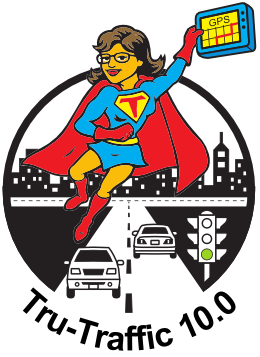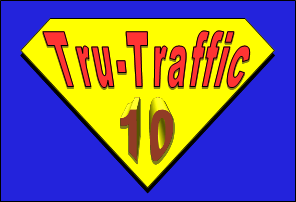


(formerly TS/PP-Draft)
Be Your City's Traffic Superhero!
- Deliver Quality-Assured Traffic Signal Coordination
- Draft Arterial Timings Diagrams
- Perform Travel Time & Delay Studies (with GPS receiver)
 |
 |
 |
(formerly TS/PP-Draft)
Be Your City's Traffic Superhero! |
||
|
||
| New! in Version 10.0 | Customizable Importing of Trip Logs or Geographic Positions! |
| Easier Network Setup! | |
| Multiple Modes of Transportation! (e.g., cars, buses, light rail, etc.) |
Features, Screenshots & Videos ...
|
|
Time-Space or Platoon-Progression diagrams on Intersecting Arteries!
Comparative Travel Time & Delay Reports from GPS Travel Time Runs!
Speed-Distance Plots from GPS Runs!
Connect the Dots to create a Signalized Network!
Import Trip Logs with a flexible, customizable Import Previewer, including factory presets for common file formats!
Import Geographic Positions with a flexible, customizable Import Previewer!
Minimize the Transition between Timing Plans!
Shift Selected Offsets or All Offsets Network Wide while preserving Coordination!
Color-Coded Links on Network View summarize Average Link Speed!
Color-Coded Trip Log Points on Network View show Instantaneous Speed!
Travel Time & Delay Report has split panels to keep the column headers in view while you scroll through the report!
This video, created by Mike Cetnarowski of DMD & Associates Ltd. and presented an an ITE conference, shows the results of a coordination project that used Tru-Traffic. The upper, inset videos appearing at 1:05 were created by Tru-Traffic.
This video, from Chris Georges's trafficlabz's channel on youtube, shows the results of synchronizing three videos of a trip through a coordinated artery, one from Tru-Traffic, one from a camera pointed out the windshield, and one from Google Earth.
This video, created by Carlos Ortiz, et al. at RBF Consulting demonstrates part of a signal synchronization project that used Tru-Traffic and other software tools. The background video was created by Tru-Traffic.
This video, created by John Albeck as part of a timing project involving multiple agencies, has a segment near the end demonstrating how to use Tru-Traffic to verify that the timings in the signal controllers agree with those designed in the software.
This video, also by John Albeck, summarizes the optimization process used for the timing project mentioned above. From the Tru-Traffic perspective, it shows a number of usages, including
This video, also by John Albeck, shows the optimized results of the timing project mentioned above. Its insets show the animation from various perspectives, including the time-space diagram and the Network View in Tru-Traffic as well as Google Earth.
This video, also from Chris Georges's trafficlabz's channel on youtube, shows a technique for looking at your GPS points in a little more detail in Tru-Traffic. It uses version 9.0, so it doesn't show some newer options in version 10.0, but it's still perfectly valid.
Also from Chris Georges's trafficlabz's channel on youtube, this video shows how to merge two files in Tru-Traffic.
| DEVELOPER | Greg Bullock |
| SUMMARY | Tru-Traffic (formerly TS/PP-Draft) is a worksheet for drafting arterial timings diagrams (time-space, platoon-progression, or time-location). Although Tru-Traffic offers some automatic optimization options, it was developed with the idea that some decisions in signal timing are based on factors that
cannot be quantified easily or accurately for a computer (e.g., driver perception, citizen complaints, queue length, local policies, etc.) and therefore must be made
by a human.
Using Tru-Traffic you can quickly develop either type arterial timing diagram for an artery, a set of intersecting arteries, or a signalized network. You may view the entire diagram or set of diagrams on the screen at once. You can easily adjust any parameter (cycle length, offset, phase sequence, splits, scales, green bands, volumes, etc.) for any intersection as often as desired, and instantly see the effects of the change. Thus, you can quickly optimize the parameters. On time-space and time-location diagrams, it automatically adjusts the green bands to show the traffic flow. On platoon-progression diagrams, it shows the flow density and queue lengths, much like the diagrams of PPD, the TRANSYT-7F post processor (except that the parameters may be changed interactively with the mouse or cursor keys, and the diagrams are displayed on the screen rather than just on the printer). Tru-Traffic allows multiple timing plans and handles signalized networks or intersecting arteries by allowing multiple diagrams, each in its own diagram window, and each representing a different artery. The common intersections are "linked" across diagram windows so that you may edit the parameters in any diagram window, and Tru-Traffic ensures that the common parameters between linked intersections stay concurrent. You may connect a GPS Receiver to your computer and let Tru-Traffic track position and speed. Use an optional remote control device or speech-recognition to control the GPS data collection while driving. The collected information may be used to:
|
| ENVIRONMENT | Requires Microsoft Windows XP, Windows Vista, or Windows 7, 8, and 10, 10Mb available memory, and 15Mb of disk space. Also, the system must have a printer driver installed, even if it's for just a virtual printer connected to print to a file, not to a real port or on the network. A GPS receiver (either NMEA 0183 compatible, or Garmin Proprietary, or DeLorme Earthmate) is required for tracking position and recording trip logs. See GPS Receiver Recommendations |
| STATUS | Ready to run. Hundreds of current users. |